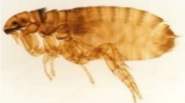Dealing with Fleas in Cats and Dogs
Posted on
Fleas are probably the most annoying and prolific type of pet pest; causing relentless discomfort and distress for our four-pawed friends (and us). They’re an external parasite whose mouthparts are adapted for piercing skin and sucking up blood – a practice known as hematophagy. They are wingless and have long hind legs for jumping, making it easy for them to travel seamlessly through fur and evade physical attacks.
There are over 2,000 different species of these little blood-sucking terrors, all with their own preferred feeding hosts. While they may prefer dogs and cats, most fleas will suck blood from any animal that’s available (including humans) if they can’t find their preferred meal.
Flea infestations can be not only annoying for dogs, cats and humans; but can also be very dangerous. Here we’ll discuss the most common cat and dog fleas and how you can fight back.
Cat Fleas
The most common type of cat flea found on household cats is known as the domestic cat flea (or Ctenocephalides felis). Like all fleas, the cat flea is compressed laterally – allowing it to slip between the dense hairs of its host just above the top layer of the skin. This can makes them extremely difficult to observe even if the host’s coat is white.
Cat fleas do not willingly vacate their hosts, and inter-animal transfer of adult fleas is rare except in animals that share sleeping quarters. When these types of fleas become separated from their hosts, they will often die from starvation within hours.
Signs and symptoms
- Intense and frantic scratching or biting: flea bites cause a cat’s skin and fur to feel extremely itchy.
- Red skin lesions or scab-like bumps: Some cats are so sensitive to flea saliva; their skin becomes red and inflamed.
- Excessive Grooming: A cat may lick repeatedly to get rid of the itchy sensation, especially around the hind legs and base of the tail.
- Hair loss: The excessive grooming may cause bald patches, especially on the back of the legs, neck and around the base of the tail.
- Avoidance of certain parts of the home: If a cat has been bitten by a lot of fleas in specific rooms (usually more so in carpeted ones)
- Muscle loss, pale gums and lethargy: These are the tell-tail signs of anaemia, which can sometimes happen with severe infestations
- Dark-brown specks on fur: Referred to as “flea dirt”, these pepper-like specks are flea faeces. They’re most often seen on the neck and rump areas.
- Red spots in your cat’s bedding material: This could be flea dirt that fell off your cat’s fur and turned red when the cat’s warm body rubbed against it.
Dog Fleas
The scientific name for the common dog flea is Ctenocephalides canis. Although dogs are their preferred hosts, they are also commonly found on cats, humans, livestock and wild animals such as raccoons and possums.
They usually feed on the blood of cats and dogs, but they also bite humans. Unlike the domestic cat flea, these can survive several months without food and deliver about 4000 eggs on the host’s fur in a single life-cycle.
Signs and symptoms
- Fleas visible on dog’s coat and skin: They are small, dark and brown and usually rest on the warmer parts of the dog: armpits, groin and ears.
- Visible “flea dirt”: Flea excrements that look like tiny pepper-like specks
- Excessive scratching or chewing: When fleas bite dogs, they scratch and bite themselves, especially in targeted areas such as the head, neck and around the tail.
- Red and bumpy skin: The incessant scratching and biting that follows may cause the dog’s skin to become red and inflamed.
- Flea allergy: dermatitis can also develop on dogs allergic to flea saliva. In this case, the above-mentioned symptoms are more pronounced.
- Hair loss and skin lesions: Because of the compulsive scratching and biting, the dog may lose hair, develop bald spots, exhibit hot spots (a raw and painful skin lesion) and develop infections that result in foul-smelling skin.
Cat vs Dog fleas
The dog flea can be distinguished from the similar cat flea by its head, which is anteriorly rounded rather than elongate, and the tibiae of its hind legs, which have eight setae-bearing notches rather than six.


Cat Flea (Ctenocephalides felis) Dog Flea (Ctenocephalides canis)
Fighting back: Treatment and Prevention
Aside from making your dog or cat miserable, fleas can also pose a serious health hazard. If your pet has sensitive skin or an allergy to flea bites, s/he can develop painful skin reactions. Also don’t forget that fleas are just as happy to bite humans, so it’s imperative to take quick action to get rid of them.
TREATING YOUR PET
1. Start with a good bath.
Give your dog or cat a thorough bath using a gentle shampoo or a citrus-based dish washing liquid. You can also use a commercial flea dip. Fleas don't grasp onto your pet's hair shaft, so they will fall into the water and drown.
After the bath, comb your pet with a flea comb. You'll also want to use a flea comb every time your pet is treated for fleas.
2. Treat all your pets using oral and topical medications
- Capstar Blue
- Advocate: for small, large cats
- Revolution: for kittens, cats (2.6-7.5kg)
-
Advocate: for medium, large dogs
-
Collar: Killtix Flea & Tick Collar
Be sure to use the correct dosage made specifically for your pet, as your pet can have a serious reaction to an overdose. Never use dog flea prevention on a cat, as a cat's nervous system can only handle feline flea preventative.
Give the flea preventative on the same day that you treat your house and yard for fleas for maximum effectiveness.
3. Wash your pet’s bedding as well as any cloth items that have been on the floor
Washing will significantly reduce the number of flea eggs and larvae on the bedding and cloth items and will make your insecticide more effective.
The wash cycle will not kill the fleas, but it may eject some of the eggs through the drain. On the other hand, the dry cycle, on normal for over 30 minutes, will kill the eggs and any fleas remaining on the cloth.
Do this all at the same time, removing everything at once and wrapping it in tied-up sheets. Keep the clean items wrapped in clean sheets or garbage bags until 12 hours after you've treated your house and your animals to prevent fleas from crawling onto the clean items.
4. Allow your pets to roam freely around your house after you’ve treated the house and your pets
Fleas will smell your pet and will jump onto their fur, and they will be eliminated soon after they bite your pet's skin.
5. Keep your pets inside as much as possible for 30 days or so
If your animal must go outside, keep it away from long grasses, fallen leaves, gravel areas or sandy patches.
If you have a dog and you need to walk the dog, try to stick to pavement for this first month. While your dog or cat is toxic to fleas jumping on them, you are trying to eliminate a nasty infestation, and you don't want to introduce new fleas to your pet when you are trying to kill off the old ones.
If possible, keep pets inside during the winter months, especially cats. Quarantining your animals can save you money because after your infestation is eliminated, you don't need to re-treat them unless you notice more fleas.
6. Continue treating your pets with flea preventative every 30 days
If your pet stays inside, then you can probably stop the flea preventative treatments after four months. However, if your pets are going outside, you may need to continue the treatments.
